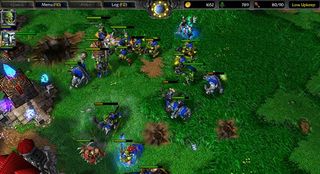If you’ve gotten decent at running your base and building your army efficiently, it’s time to learn how to scout. If you learned a build order from a pro, you’ll have seen already that every good player sends a unit out early to find the opponent’s base. Sending a scout early has few exceptions, so get used to sending one in every game. Some RTS games actually provide you with a scout unit (like Age of Empires), but if it doesn’t, you need to send something else. Often this is a worker. Yes, you’ll harvest fewer resources, but information is critical. The easiest thing to do is to send the scout in a circle around the map by using way points – right click on the nearest spot where your opponent could be, and then hold shift and right click the remaining starting points on the map. If you don’t know where the starting points are on the map, you’ll learn them by scouting (use the minimap and send your scout to where you see resource patches). By using way points, you can then go back to your base and build stuff you need and the scout will check the map for you.
To advance this technique, practice looking at the minimap as your scout approaches each potential starting point – if you see enemy colors, jump to your scout (keep him in a control group, and always the same group number every game). Early in the game, your opponent usually won’t have anything that can easily kill your scout, so run it right up into his base and look around. What buildings does he have? Anything unusual, like two barracks, which are a warning he’ll probably rush you? Knowing what things in the enemy base mean for strategy takes time to learn, and scouting is part of the learning, because you go in their base, make note of what they have, and then when they reveal their strategy later, you’ll know what those early buildings mean.

Above: This Zerg player is scouting with his Overlord, which is actually a house. But since it can move, it makes a perfect early scout. Get creative with what you use to scout
Mediocre players learn how to scout early, but then don’t scout after finding the opponent. The second important way to scout is to check if your opponent is expanding (building a second command center at another resource point in order to gather resources faster). If you periodically send a scout around the map looking for expansions, you can potentially catch an expansion early and destroy it, or punish your opponent by attacking his main base while his resources are tied up building the expansion.
Scouting makes a gigantic difference in the quality of a player, so if you can get even halfway decent at it, you’ll see your victories pile up. Other aspects of scouting to explore, once you get the first scout and expansion scout down, are: re-scouting the main base to observe tech levels and special unit-producing buildings, posting scout units outside your base as an early warning against attacks, posting units permanently at expansions, and learning special scout abilities (some games have abilities that reveal portions of the map). There are also ways to defend against scouting: walling off your base with buildings, hiding certain buildings in unusual spots to keep your strategy a secret, and a really advanced technique - “feint” buildings (you build something to make your opponent think you’re going for certain units, which he’ll see when he scouts you, and then you secretly place different buildings elsewhere and use those units instead).

Above: The same Zerg player as before has posted a single zergling at his opponent’s closest resource patch, known as the Natural Expansion because it’s where he’ll most likely first expand. Now, if the opponent tries to expand there, the Zerg player will see it – he may lose the zergling, but it will be worth it for the info
Basic scouting is not difficult – it just takes mindfulness to remember to do it. Increasing your scouting is the best way to become an advanced player, and doesn’t require insane clicking skills, allowing you to out think more dexterous opponents.
Strategies
It may seem weird to tackle strategies after learning everything else, but in RTS games, strategies are only effective if you can pull them off, which requires speed, lots of workers, efficient resource spending, and at least basic scouting. Many newbies try to analyze their losses from a strategic view, and this is pointless – if you’re slow, inefficient, and don’t scout, your strategy is not the problem.
Since every RTS has unique strategies, I’m going to cover the general foundations that can apply to every RTS. First, your strategies need a purpose – you can’t just build random mixes of units because it’s “fun.” After practicing the elements of resource management and scouting against human opponents, you should develop an idea for what strategies are popular. You’ll want to put together a few strategies designed to counter the most common opposing strategies. Don’t get too crazy at first – just focus on a small number of strategies that can work in multiple situations. You’ll need to learn unique build orders for each one.
You can’t be above using “cookie cutter” strategies. The reason they are cookie cutter is because they are either extremely efficient at a single purpose (like rushing), or they are versatile - able to deal with multiple opponent strategies, or they are low-risk. You’ll notice that gimmick strategies are usually high-risk and all-in – if you mess up, you’ll lose. This is why top players usually won’t use them except in special circumstances, like if they see a particular strategy their opponent is doing and know a gimmick that can counter it.

Above: The Orcs in Warcraft III have this cookie cutter strategy. Blademaster and Shadowhunter as heroes, supported by Grunts, Raiders, and Spiritwalkers. It’s ubiquitous for two reasons: 1) It can take on almost any strategy, and 2) It’s all designed to make the Blademaster as powerful as he can be, and he’s already arguably the best hero in the game
One of the hardest aspects of competitive gaming is admitting that something you like is not viable in competition. It’s rare for an RTS to have all of its units be worthwhile, so part of becoming better is sucking it up and abandoning the “cool” units. If you don’t see pros ever using a particular unit, sit back and ask why this is. Typically, a unit will become useless if there’s another unit that performs its job better, or performs its job nearly as well and also performs some other job. Often times, late-game units aren’t viable because they take too long to get to and/or cost too much. Those mega-units that seem so imposing are in fact not so hard to kill, and a small micro mistake (we all make them) can get it picked off, and then all your resources and time spent getting it are wasted. It doesn’t mean you can’t ever use them in competition, but it does mean you need to know what you’re doing if you’re going to use them, and know when you shouldn’t use them (which is usually most of the time).
There are three basic strategies that work in a rock-paper-scissors dynamic in most RTS games. They are: Massing, Teching, and Fast Expanding. In principle, each beats one other, but your execution and cleverness can shift the dynamic significantly.
Massing is when you focus on large numbers of early-game units with the aim of overwhelming your opponent quickly. There are variations like rushing, where you attack as early as possible, or pushing (a slightly later all-out assault). Massing doesn’t have to mean you just keep pumping out the same units – you can mass at first and then later on go for higher-tech units. Typically, Massing beats Fast Expanding because you can swarm an opponent’s early expansion with superior numbers. Note that all-out Massing is a high risk strategy – if you don’t do proper damage early on, you’ll fall behind for the rest of the game.
Teching is when you build only a few or even zero early units and focus your resources on shooting up the tech tree quickly to get to the more powerful units. Teching typically beats Massing because you can shore up your defenses in your main base with a couple of towers and hold off the massed army long enough to get units that will beat them.
Fast Expanding involves a resource grab early. See the section below for details. However, know that Expanding typically beats Teching, because although your opponent will get to powerful units before you, his small early force won’t be able to stop your expansion, and so when he finally does get to his high-tech units, you’ll have more resources and can win by attrition.

